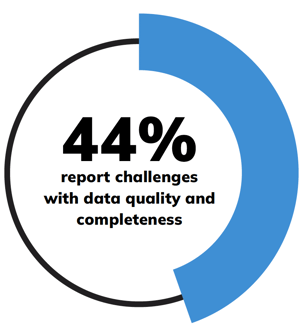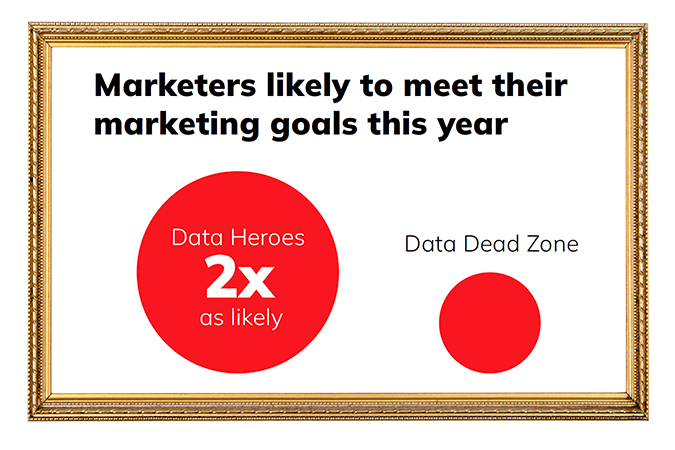Don't get caught in the Data Dead Zone in 2024
It’s possible to escape the Data Dead Zone. Better data, and better marketing, is within reach.

Introduction
B2B marketers have a tough situation on their hands. On one side, their goals are more challenging than ever. On the other side, their budgets are being squeezed. Having to do more with less is tough, and B2B organizations are making it even tougher, requiring marketers to “prove it or lose it.” That is, show that they’ve driven revenue, or lose budget.
At the same time, B2B buyers are changing significantly. They’re much more likely to use online channels to search for information, research solutions and even transact online. Winterberry Group calls this the “consumerization” of B2B marketing in their recent report “Outlook for B2B Marketing, A Market In Transformation.” B2B buyers are starting to look more like B2C buyers, and it’s dramatically shifted the strategies that B2B marketers need in order to succeed. Regular consumers search, shop, and transact online in large numbers, and B2C marketers have spent years collecting customer data and creating data-driven technology stacks to market to them based on their online behavior.
Our research shows that there are some B2B marketers who are thriving through this time of change. Their secret? Better data and better use of data. They reported in the 2023 Data Impact Report that they have the right data and can prove it in their pipeline.
We’ve defined these B2B marketers as Data Heroes. These marketers saw significant growth in the past year (43% saw significant revenue growth vs 13% of other marketers) and are getting bigger budgets (78% of them!) because of their data-driven approach.
However, there are plenty of marketers who aren’t experiencing the same data-driven nirvana. Of all the marketers surveyed, 44% of them reported challenges with data quality and completeness. These unfortunate marketers are in the Data Dead Zone. While 100% of the Data Heroes report they use the right data and can prove it in their pipeline, only 26% of those in the Data Dead Zone could say the same.

Five signs that you’re in (or nearing) the Data Dead Zone.
Issues with data quality and completeness
We defined those being in the Data Dead Zone as the B2B marketers who reported a top challenge associated with 2nd and 3rd party data being its data quality and completeness because good, comprehensive data is the key to a successful marketing strategy. While 100% of marketers in the Data Dead Zone are challenged by data quality, only 44% of Data Heroes are.
B2B marketers in the Data Dead Zone lack confidence in their data, and that can affect their entire marketing strategy. Chances are data is old, sitting in different databases, or not coming from top-quality sources. When this happens, your data isn’t powering your audience insights, targeting, and measurement as it should be.

The fix: Time for a data audit.
Look at the data you have available and determine what’s needed to improve quality and completeness. If data is old, see if there’s a way to gather newer data or work with partners who offer real-time data or more regular refreshes. If data isn’t aggregated, talk to stakeholders about bringing data together into one technology platform or data cloud for a “single source of truth.” And if data is incomplete, start testing new data sources to see what new insights you can add that can deliver incremental performance.

Not using third-party data
Intent data is a newer form of buyer insight that helps you prioritize and personalize marketing outreach. If someone shows stronger intent to buy, they should be getting more attention and a higher lead score. Knowing what a prospect intends to buy can help you tailor content and offers to their needs. Not surprisingly, marketers in the Data Dead Zone aren’t as experienced with intent data, aren’t able to drive as much value with it, and so aren’t planning to use more of it; only 4 out of 10 of these marketers currently use intent data. Marketers in the Data Dead Zone are also more likely to be using intent data from their own sources such as their website, vs. third-party intent data.
This matters because they likely aren’t seeing the full scope of intent data that they could unlock through a third-party intent provider. While they can see a small portion of a prospect's behavior that points to intent, like downloading an eBook from their site, they aren’t able to get the full story of how they are engaging on other websites and platforms. This means they’re also missing out on prospects who aren’t engaging on their site but are showing high intent for their products or services.
On the other hand, Data Heroes are getting the most out of intent data. They are not only using intent, they are using it for more than just targeting and content; they’re implementing more sophisticated use cases.
The fix: Time to test more intent data.
Think about the entire buyer journey – a lot of it happens off of your website. Marketers with access to intent data from search, third-party research sites, and other sources will be able to recognize what marketing messaging might be most effective, when someone is ready for content specific to a phase in the purchase journey, or when to have a seller reach out. It’s worth testing intent data from third parties to see what competitive advantage you can gain.

Unhappy with lead scoring methodology
Lead scoring is the thread that runs through most marketing programs. It’s what ties marketing to sales, what leaders use to gauge the value of marketing activity, and how marketers prioritize one marketing strategy over another. When lead scoring isn’t working, it’s hard for marketers to get anything right.
The vast majority of Data Heroes, 83%, are satisfied with their lead scoring, compared to only 36% of marketers in the Data Dead Zone. What’s more, Data Heroes are more likely to be using newer scoring techniques – 61% of Data Heroes use buying group scoring compared to only 42% in the Data Dead Zone. Marketers in the Data Dead Zone are most likely to be focused on engagement. While scoring for content consumption or engagement may not tell the whole story, it is OK to have it as part of your scoring methodology. What sets Data Heroes apart is they are layering more metrics to tell a more complete story for their leads.

The fix: Dig deeper and layer on more data points.
If you’re stuck only measuring engagement, you’re still in the dark about the real value of your leads. It’s worth the effort to dig deeper and layer on more data points to see what you can do to connect the dots from individual behaviors and signals to actual purchase. This might require a third-party data partner to help measure and model it out, but you’ll be left with a much more accurate understanding of how to score leads that will drive value now and in the future. For marketers looking at individual leads, now’s a good time to aggregate those leads into buying groups. Gartner notes that a typical B2B purchase includes anywhere from 6-10 stakeholders. Mapping these stakeholders together can create a much more accurate picture of who is involved in the buying process allowing you to customize outreach to each buying role. Since members of the buying group have different priorities and levels of involvement you can improve your lead velocity by engaging the whole buying group with customized messaging.

Little exposure to B2C marketing tactics
The fix: Start to map your new B2B buyer journey.
It’s likely many of them have started to use more online channels, be more self-directed in their purchase process, and expect personalization. You can interview prospects and new customers, work with your data partners and talk to your agency to create an accurate picture of your prospects. Prioritize a few changes that could help align your marketing activity with your prospect behavior. There might also be holes in your customer journey where you don’t provide enough online support or don’t have good insight that require new data or technology capabilities. Starting conversations with potential partners can help create a good understanding of what’s working for your peers and what you can do to fill those gaps.
Trouble meeting goals
Marketers in the Data Dead Zone have a tougher time meeting goals; they are half as likely than the Data Heroes to have reported that they are very likely to meet their marketing goals this year. The difference is in the details. If any of the issues above are plaguing your team, then meeting goals is going to be tough.
The fix: Make an action plan.
Rather than give in to the Data Dead Zone, now’s the time to create a plan to get out of it. For skeptical executives who think your data is just fine as it is, have them compare your current situation to the Data Heroes in this report and in our report 4 Steps To Become a Data Hero.

Download the full report and bookmark these tips.
Keep this guide nearby as you navigate the year and execute your marketing strategy. Avoid slipping into the Data Dead Zone.
Ready to act? This checklist is your next stop.
To get started, follow this checklist with the simplified actions B2B marketers should take to get out and stay out of the Data Dead Zone.




